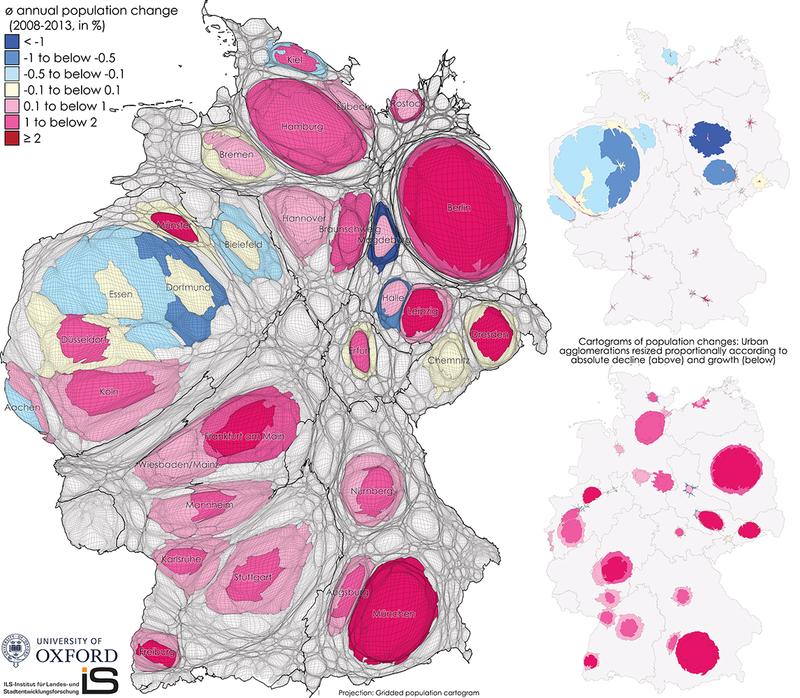
Visualizing Urban Change: Understanding Germany’s City Dynamics

Cartograms of population changes in urban agglomerations in Germany (2008-2013)
Benjamin Hennig, Stefan Kaup / © 2015 School of Geography and the Environment, University of Oxford and ILS - Research Institute for Regional and Urban Development, Dortmund, Germany
The Research Institute for Regional and Urban Development (Institut für Landes- und Stadtentwicklungsforschung, ILS) investigates new social processes, especially those involving urbanisation in Germany and Europe.
This includes economic, social and structural processes that are compared and monitored over time to gain a better understanding of the underlying developments. Testing state-of-the-art visualisation techniques are a significant part of this effort.
This was the focus of a collaboration between researchers of the University of Oxford and the ILS Dortmund which resulted in the development of a series of highly effective maps called “cartograms” that provide new insights in the changing geographies of city regions in Germany.
The method used in the research creates gridded cartograms in which equally-sized grid cells are resized according to number of people in any area. The resulting map looks as if the reader has placed a magnifying glass on the most densely populated regions while sparsely populated areas are much smaller than they appear on a land area map.
This allows additional spatial information such as socio-demographic data to be shown in their relation to population. Using such visualisations dynamic changes, such as shifting populations, can be analysed in their spatial as well as their human context.
Approximately half the population of Germany lives in the 30 major urban German agglomerations, such as Berlin, Hamburg, Munich (München), and Cologne (Köln) but also in smaller cities including Münster, Freiburg, Leipzig, and Dresden. The gridded cartogram helps to understand the demographic processes and development that occurred there in recent years, revealing some distinct trends of re-urbanisation in some of the most densely populated areas.
Examination of the average annual change in the populations of the selected urban agglomerations highlights the regional differences in these trends. Contrary to the national population decline, which is predicted to continue, 26 out of the 30 major agglomerations show population growth between 2008 and 2013. In 25 of these areas population growth in the city centre is even higher than in its suburban area. This can be seen as evidence of a very recent trend of re-urbanisation in these places.
One particularly notable trend is the dynamics in smaller cities such as Freiburg and Münster, as well as Dresden and Leipzig in east Germany. In addition to high rates of re-urbanisation, the suburban areas often have stagnating or even declining populations.
The Ruhr area agglomerations are distinctively different from the other areas described in the overall summary of trends. The stagnating populations in the centres of Dortmund and Essen are complemented by considerably declining populations in their surrounding areas.
Two cartograms depicting growth and decline have been produced as separate maps. These reveal, population decline in the settlements in the Ruhr area that is larger than in all other urban agglomerations put together. Growth, in contrast, is spatially spread much more evenly.
Amongst the influencing factors or growth and decline are developments in social structures, employment as well as changes in land development in these regions. How these factors are interconnected and influence each other is part of further research within this project that aims at establishing a long-term geomonitoring of these regions in order to better understand these new forms of urbanisation in Germany that are currently only just beginning to emerge.
Supplementary material including high resolution graphics of the maps is available as a download via the following link: http://wrld.at/prils
For more information please contact:
Dr. Benjamin Hennig
School of Geography and the Environment der University of Oxford
E-Mail: benjamin.hennig@ouce.ox.ac.uk
Stefan Kaup
ILS – Research Institute for Regional and Urban Development, Dortmund, Germany
E-Mail: stefan.kaup@ils-research.de
http://www.viewsoftheworld.net/?p=4604
http://www.ils-forschung.de/index.php?lang=en&s=geoinformation_und_monitorin…
http://www.worldmapper.limited
http://www.geog.ox.ac.uk/staff/bhennig.html












